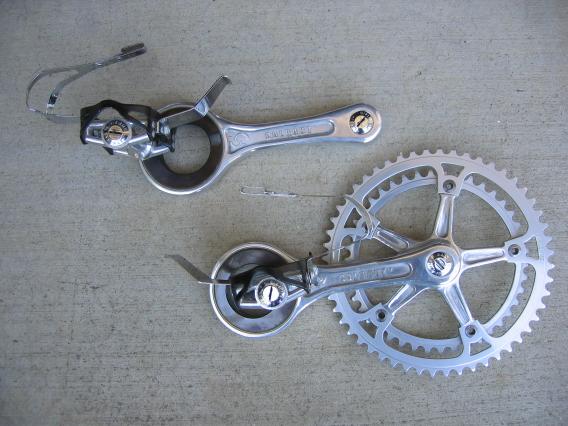
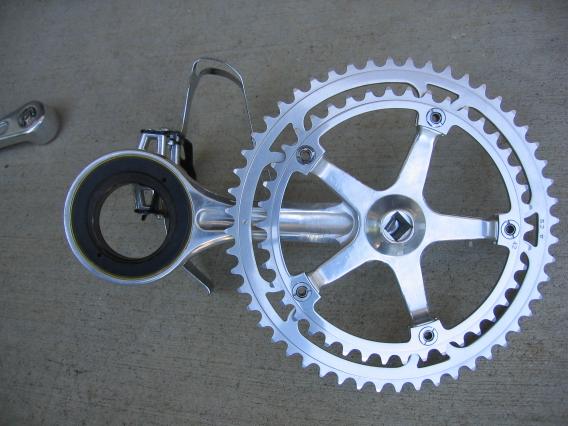
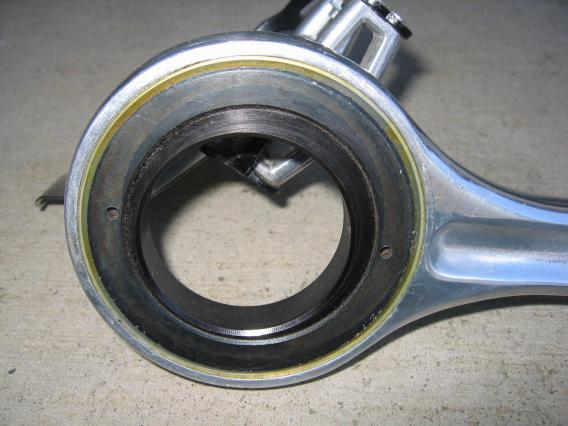
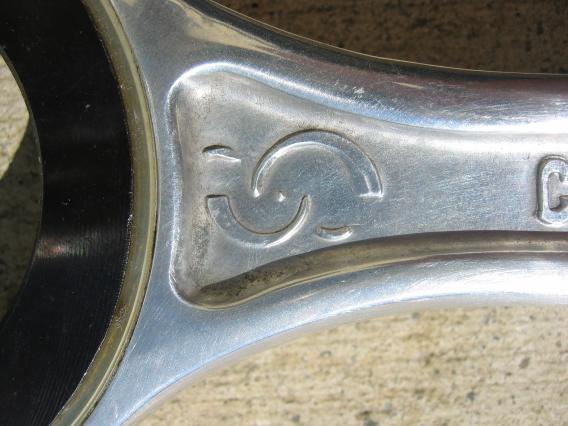
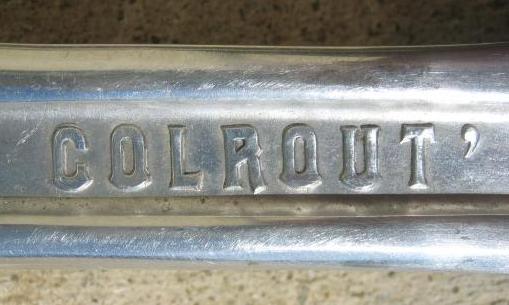
See also also bike pic for other bike-related technical discussions and more failed parts.
See also also The Bicycle Museum of Bad Ideas for more wAcKy bicycle designs.
Gipemme Colrout cranks and integrated pedals. Unknown vintage and background. Marked various places with
Gipiemme Italyand the vanity groove is marked
COLROUT'
Background on Gipemme: from http://www.classicrendezvous.com/Italy/Gipiemme_main.htm as of 2007/06/15:
Gipiemme is still involved in the bicycle trade but has realigned it's product offering. In the 1970s it offered, among other levels, the Special series components that rivaled Campagnolo.
"Gipiemme a world-renowned brand synonymous with top-end cycle components for race and MTB was acquired by Isca SpA group in 1989."
http://www.iscaselle.com[Link dead as of 2011]
The crank has a standard square taper, but the pedal eye is approx 82mm diameter. A bearing is fitted in the eye. The inner race has a pedal stub rigidly attached at about 62mm diameter (31mm radius). A pedal is attached rigidly to the stub. The crank's ``pedal eye'' bearing has rubber seals on both the inside and outside. The bearing layout is unknown but is presumed double-row ball.





There are no bearings between the pedal and the stub, so the pedal has a fixed relationship to the inner race. The pedal and race are oriented so when the pedal is level, the pedal cage is forward of the crank, in all crank positions. Here are pictures taken every 90 degrees through one full revolution. Note the downstroke is with the pedal to the left in the pictures, the upstroke is with the pedal to the right.
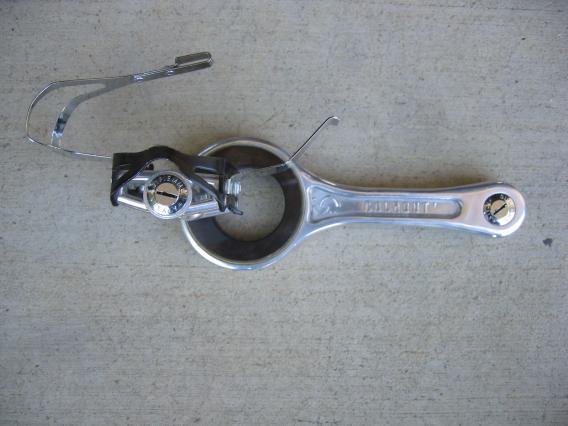
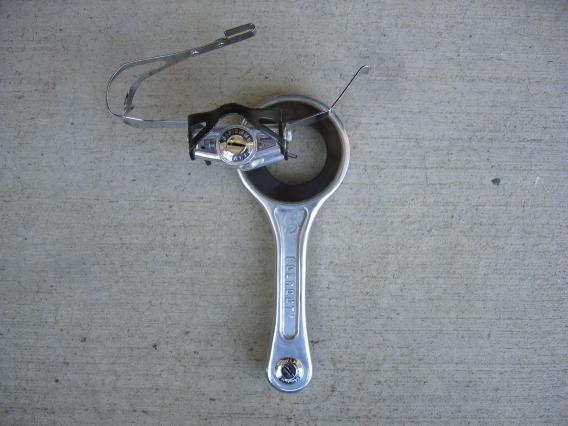
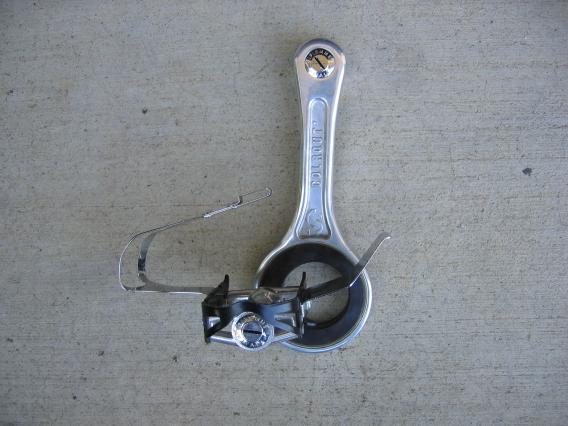

Not much is known about these cranks or their original marketing.
It appears the goal is to place the pedal farther from the spindle on the downstroke for increased leverage -- as with a longer crank, but without increasing the total distance traveled by the foot and thus without other disadvantages of longer cranks.
The pedal cage follows an offset path — it travels in a circle, but the "dust cap" of the pdeal is further from the crank spindle when the pedal is ahead of the bottom bracket, and closer when the pedal is behind.
To analyze the true operation it is useful to first consider a standard pedal in isolation, say bolted to a stand. The foot presses on the cage both in front of the spindle and behind the spindle. The average force is always centered on the spindle: if more force is behind the spindle, the pedal rocks back until the front comes up and presses hard enough on the underside of the shoe to balance the force on the rear. Similarly, if more force is ahead of the spindle, the pedal rocks forward until the rear comes up and balances the force in the front.
Now consider the Colrout: the center of rotation is not about the pedal "dustcap", but about the center of the bearing in the crank's pedal eye. The whole pedal cage is ahead of the center of rotation, so load placed anywhere on the pedal body causes the pedal to rotate down and back about the bearing. If the Colrout used only a simple cage, the pedal would rotate down until it was at the lowest point, and the rider's foot would wind up pressing on the back of the pedal cage. However, the Colrout uses a metal support that reaches back. When the rider's foot presses on the cage, the cage rotates down until the rear support comes up enough to balance.
Thus, while the visual effect is a pedal offset from the pedal eye, the true mechanical effect is still a platform which rotates about the center of the crank's pedal eye — just like a standard pedal. The sole effect which is different than a standard crank and pedal is to shift the toeclip forward, and thus shift the rider's foot forward, as if a standard pedal were used with a 31mm longer toe clip.
However, the Colrout achieves this at greater weight, cost, and friction, and with reduced reliability.
Note that an offset pedaling circle could be achieved using a standard pedal and a Vietor/Erich Split Crank/Kingsbury K-Drive (see http://tilting.org.za/bok/kstory.html as of 2011/06) with 1:1 gearing instead of the usual 2:1. A similar shape may also have been achieved by the "Power Pedal", using a telescoping crank that is positioned with an offset cam (see http://www.sonic.net/~ckelly/Seekay/weird_bike_stuff.htm as of 2007/09).
Apparently, the idea is older than the Colrut: from [https://restoringvintagebicycles.com/2021/12/22/eccentrics-in-cycling as of 2024-05-13] without any explanation:
![[tx318783a.webp]](i0.wp.com/restoringvintagebicycles.com/wp-content/uploads/2021/12/tx318783a.webp)
The crank is of a style which was used in the early 1900s. It seems possible the crank in the picture is also from the early 1900s.
Colrout cranks are mentioned in "Cyclepedia - A tour of Iconic Bicycle Designs", by Michael Embacher (more here), which says
![[14_cyclepedia_jp160311.jpg]](www.wallpaper.com/galleryimages/17052375/gallery/14_cyclepedia_jp160311.jpg)
The Gazelle Champion Mondial road bicycle (circa 1981), apart from its enjoyable riding experience, became renowed for its original Colrout cranks - the crank lever was at least 34 millimetres short of the standard.
Though as described above, the crank is no shorter.
Another exerpt (here) says![[book-gazelle.jpg]](www.smart-move.at/img/book-gazelle.jpg)
![[book-gazelle2.jpg]](www.smart-move.at/img/book-gazelle2.jpg)
![[book-gazelle3.jpg]](www.smart-move.at/img/book-gazelle3.jpg)
The Colrout cranks are, in any case, unusual. In France, where they were manufactured, they are identified as "manivelle a excentrique" — we can certainly undestand the eccentric part. On the down stroke, the crank arm was 34 mm longer, and an equal amount shorter on the up stroke. The handlebars and seat shifte 34mm forward so that the seat position would fit into the usual scheme. But in the end, evolution passed it by.
Again, the arm is not actually longer. Also, the detail picture shows this set does not have a rear-sticking plate on the pedals, which would make them more difficult to use.
In contrast, here is an example which is fitted with the plate (shown here):
![[download-140224-800.jpg]](www.vorb.org.nz/download-140224-800.jpg)
The same page also shows the "Easy Crank", which telescopes and thus behaves as the writers above think, wrongly, the Colrout behaves.
![[download-140223-800.jpg]](www.vorb.org.nz/download-140223-800.jpg)
More at http://pardo.net/bike/pic